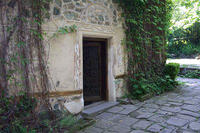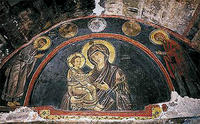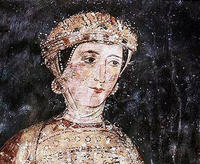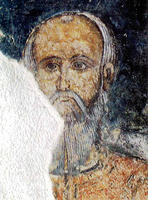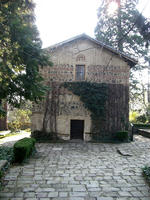You are in: Europe -> Bulgaria -> Boyana Church, and traditional search or Image Gallery will yield results of this site only
Boyana Church
| Site number: | 42 |
|
| Type of site: | Cultural | |
| Date: | 11th-13th&19th | |
| Date of Inscription: | 1979 | |
| Location: | Europe, Bulgaria, Boyana District, Sofia | |
Up to 75 images are shown here. Click on each for more details or on Image Gallery for more images.
| Description: | Boyana Church, found on the outskirts of Sofia, is made up of three buildings. The eastern church section dates back to the 10th century, but in the early 13th century it was enlarged by Sebastocrator Kaloyan, who decided on a second two-storey building being erected next to it. The second church’s frescoes, painted in 1259, are one of the most important collections of medieval paintings. A third church, built at the beginning of the 19th century, completes the site’s ensemble. The medieval art found in this site is one of the most complete and perfectly preserved monuments among similar east European art. --WHMNet paraphrase from the description at WHC Site, where additional information is available. | |
| The Boyana Church (Bulgarian: Боянска църква, Boyanska tsarkva) is a medieval Bulgarian Orthodox church situated on the outskirts of Sofia, the capital of Bulgaria, in the Boyana quarter. The east wing of the two-storey church was originally constructed in the late 10th or early 11th century, then the central wing was added in the 13th century under the Second Bulgarian Empire, the whole building being finished with a further expansion to the west in the middle of the 19th century. The church owes its world fame mainly to its frescoes from 1259. They form a second layer over the paintings from earlier centuries and represent one of the most complete and well-preserved monuments of Eastern European mediaeval art. A total of 89 scenes with 240 human images are depicted on the walls of the church. The painter is anonymous, but is possibly from the Tarnovo Art School. 18 scenes in the narthex depict the life of Saint Nicholas. The painter here drew certain aspects of contemporary lifestyle. In The Miracle at Sea, the ship and the sailors' hats recall the Venetian fleet. The portraits of the patrons of the church — Sebastocrator Kaloyan and his wife Desislava, as well as those of Bulgarian tsar Constantine Tikh and Tsaritsa Irina, are thought to be among the most impressive and lifelike frescoes in the church, and are located on the north wall of the church. Besides the first layer of 11th-12th century frescoes, of which only fragments are preserved, and the famous second layer of murals from 1259, the church also has a smaller number of later frescoes from the 14th and 16th-17th century, as well as from 1882. The monument was added to the UNESCO World Heritage List in 1979. The frescoes were restored and cleaned in 1912-1915 by an Austrian and a Bulgarian specialist, as well in 1934 and 1944. The church was closed for the public in 1977 in order to be conservated and restored and once again opened in 2000.The Boyana Church was built in three stages: in the late 10th and early 11th, the mid-13th, and the mid-19th centuries. The oldest section (the eastern church) is a small one-apse cross-vaulted church with inbuilt cruciform supports. It was built in the late 10th and early 11th century. The second section, which adjoins the eastern church, was commissioned by Sebastocrator Kaloyan and his wife Dessislava and in the mid-13th century. This building belongs to the two-floor tomb-church type. It consists of a ground-floor family sepulchre with a semi-cylindrical vault and two arcosolia on the north and south walls, and an upper-floor family chapel identical in design to the eastern church. The exterior is decorated with ceramic ornaments. The last section was built on donations from the local community in the mid-19th century. --Wikipedia. Text is available under the Creative Commons Attribution-ShareAlike License. | ||
| Source: | http://whc.unesco.org/en/list/42 | |
| Reference: | 1. UNESCO World Heritage Center, Site Page. | |












